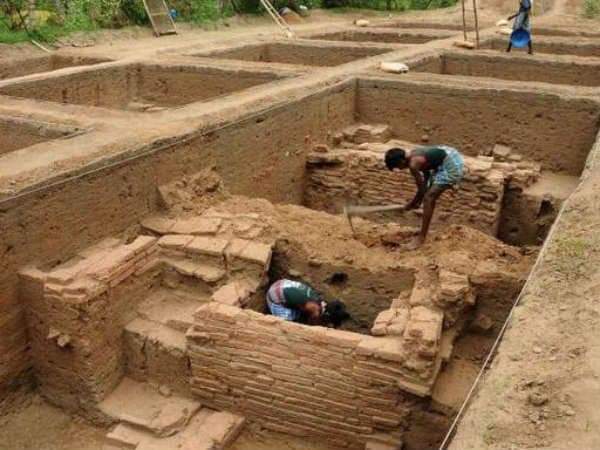Archaeologists come up with rare findings in Tamil Nadu
Context:
In Tamil Nadu’s Pudukottai district, where the State Archaeology Department has started excavation this year, archaeologists have found a gold stud, a bone point, and a carnelian bead.
What were the artefacts found in Pudukottai?
Gold Stud:
- In one of the trenches, it was discovered at a depth of 133 cm.
- has a six-petal flower pattern.
- It is reported to have been used as a nose stud and weighs 0.26 grammes.
- reveals the Sangam Age’s cultural customs.
Bone Point:
- Found in another trench at a depth of 140–160 cm.
- has carved pointy tips on both sides.
- probably employed in weaving.
Carnelian Bead:
- A broken fragment of this red, spherical carnelian bead was found between 140 and 160 centimetres below the surface.
- Domestic trade is linked to carnelian beads.
- Gujarat-made beads with a similar design have been discovered in other Tamil Nadu sites.
Where were the digs that uncovered all of these artefacts?
- About 6.5 km to the east of Pudukottai town is Porpanaikottai.
- The location was chosen for excavation based on earlier research utilising Light Detection and Ranging (LIDAR), a technique for distant sensing, which revealed the existence of a fort.
- Within the fort, a 1.26-hectare dwelling mound is the subject of the ongoing excavation.
- Eight trenches have been created, six of which are in three different people’s homes.
- The excavation is being carried out by 35 labourers and research academics A. Sudhakar, S. Munusamy, and S. Bharath under the direction of Mr Thangadurai, the Excavation Director.
What is LIDAR used in these excavations?
-
- (Light Detection and Ranging) technique for locating far-off objects and figuring out their location, speed, volume, or other details by examining the pulsed laser light that bounces off of their surfaces. Position of an object or person about true north; also known as LADAR.
- There are two types of LIDARs used.
- Airborne LiDAR
-
-
- LiDAR sensors are mounted to drones or aircraft for airborne LiDAR.
- The target surfaces emit laser beams that are then reflected by them.
- Distances are calculated by measuring the amount of time it takes the laser to return.
- Accurate 3D models of the terrain or objects are produced when GPS and inertial measurement devices are combined.
- Archaeologists can find hidden cultural features by using airborne LiDAR, which can cut through vegetation.
- It offers comprehensive aerial panoramas of the entire archaeological site.
- Using LiDAR data, archaeologists can spot trends, comprehend the context of the surrounding environment, and organise focused digs.
- It aids in the tracing of ancient cities, highways, and buried constructions.
- Analysis of the relationships between various features inside a place is aided by airborne LiDAR data.
- It offers a non-intrusive and effective way to gather data across vast distances.
-
- Ground-based LiDAR:
-
- Portable LiDAR systems mounted on tripods or moving objects are used in ground-based LiDAR.
- It enables exact three-dimensional reproductions of historic buildings or artefacts.
- A variety of scan angles are used to produce thorough 3D representations of the target.
- LiDAR which is based on the ground can provide precise details on an object’s dimensions, shape, and spatial relationships.
- It makes it possible to survey and record archaeological sites precisely.
- LiDAR data can be used to document failing or vulnerable structures digitally for preservation purposes.
- Ancient structures can be virtually reconstructed with the help of ground-based LiDAR.
- It helps with architectural analysis, comprehending building methods, and researching cultural elements.
- Archaeologists can use LiDAR to spot minute changes in the topography or surface features that might point to buried or concealed structures.
So Concluding, The Sangam Age fort at Porpanaikottai in Tamil Nadu structural details, commercial ties, and cultural practises are all well-understood via the lens of these discoveries.





